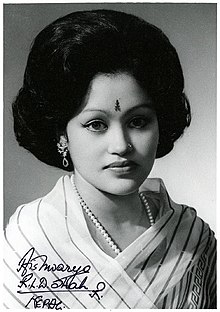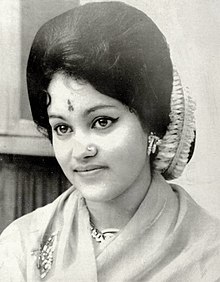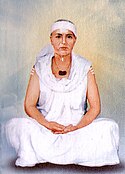Queen Aishwarya of Nepal
| Aishwarya | |||||
|---|---|---|---|---|---|
 Queen Aishwarya in 1972 | |||||
| Queen consort of Nepal | |||||
| Tenure | 31 January 1972 – 1 June 2001 | ||||
| Coronation | 24 February 1975 | ||||
| Born | 7 November 1949 Lazimpat Durbar, Kathmandu, Kingdom of Nepal | ||||
| Died | 1 June 2001 (aged 51) Narayanhiti Royal Palace, Kathmandu, Kingdom of Nepal | ||||
| Cause of death | Assassination (gunshot wounds) | ||||
| Spouse | |||||
| Issue | Dipendra of Nepal Princess Shruti of Nepal Prince Nirajan of Nepal | ||||
| |||||
| House | Rana; by birth Shah; by marriage | ||||
| Father | General Kendra Shumsher Jang Bahadur Rana | ||||
| Mother | Shree Rajya Lakshmi Devi Shah | ||||
| Religion | Hinduism | ||||
Aishwarya Rajya Lakshmi Devi Shah (Nepali: ऐश्वर्य राज्य लक्ष्मी देवी शाह) (7 November 1949 – 1 June 2001) was the Queen of Nepal from 1972 to 2001, also referred to as Bada Maharani (बडामहारानी). She was the wife of King Birendra and the mother of King Dipendra, Prince Nirajan, and Princess Shruti. She was the eldest among the three daughters of the late General Kendra Shumsher Jang Bahadur Rana and Shree Rajya Lakshmi Devi Shah in Lazimpat Durbar, Lazimpat, Kathmandu.[citation needed]
She was celebrated as a woman of classical beauty, famous for her hairstyles and dressing.
Education
[edit]She had her school education at St. Helen's Convent of Kurseong, India, and St Mary's of Jawalakhel, Nepal. She passed S.L.C. from Kanti Ishwari Rajya Laxmi High School in 1963. She was enrolled in the Tribhuvan University-affiliated school, Padmakanya College and graduated in arts in 1967.
Family background
[edit]She was from the Rana family which had ruled Nepal for 104 years. She was the eldest daughter of General Kendra Shumsher Jang Bahadur Rana (1921–1982) and his wife, Shree Rajya Lakshmi Shah (1926–2005). She had two brothers (Suraj Shumsher Jang Bahadur Rana; Uday Shumsher Jang Bahadur Rana) and two sisters (Queen Komal Rajya Lakshmi Devi Shah; Princess Prekshya Rajya Lakshmi Devi Shah).[citation needed] After her death, her younger sister Komal became queen consort of Nepal. Her family had been the effective rulers of Nepal until the 1950s. In 1970, she married Birendra, then Crown Prince of Nepal (and her second cousin).

Aishwarya's youngest sister Prekshya also married into the Shah dynasty, marrying Gyanendra and Birendra's brother Prince Dhirendra who was killed in the palace massacre. They divorced in the 1980s.[1] Princess Prekshya was killed in a helicopter crash on 12 November 2001.
Queen of Nepal
[edit]After King Mahendra died in 1972, Birendra became the King and Aishwarya the Queen consort.
Aishwarya was energetic, outspoken and a woman with beauty and brains.[2] She arranged different social and cultural programmes. Queen Aishwarya supported her husband in every steps of her life though difficulties came across them. She was a far-sighted woman who could understand the needs of the country and its people.
The country people took her support for her husband as her dominant nature, but with the passage of time, Queen Aishwarya's dominance over her husband reportedly mellowed down and she was seen as a caring companion for her husband, whose popularity increased with time.[3]
Literary works
[edit]She was interested in literature and, under the pen-name Chadani Shah, wrote dozens of poems, which have been collected under the title Aphnai Akash Aphnai Paribesh. The anthology is prefaced with criticisms about Chadani Shah's writing by veteran critics of Nepalese literature. She was also a famous song composer, and her songs were frequently aired by Radio Nepal and Nepal Television.
Murder
[edit]Queen Aishwarya was shot dead along with her husband, King Birendra; her son, Prince Nirajan; her daughter, Princess Shruti; and seven other royal family members in the June 1, 2001 palace massacre. It is widely believed that the motive for the murder was the strong opposition to the Crown Prince's proposed marriage to Devyani Rana. Queen Aishwarya's face was so badly disfigured by the gunshot wound that, for the widely attended state funeral procession, it was covered by a porcelain mask bearing her likeness.[4]
Honours
[edit]National
[edit]- Kingdom of Nepal:
- Member with Collar of the Order of Mahendra[5]
 Member Grand Cross of the Order of Honour[6][7]
Member Grand Cross of the Order of Honour[6][7] Member Grand Cross of the Order of the Benevolent Ruler[8][9]
Member Grand Cross of the Order of the Benevolent Ruler[8][9] Member Grand Cross of the Order of Gorkha Dakshina Bahu[citation needed]
Member Grand Cross of the Order of Gorkha Dakshina Bahu[citation needed] King Birendra Investiture Medal (24 February 1975)
King Birendra Investiture Medal (24 February 1975) Commemorative Silver Jubilee Medal of King Birendra (31 January 1997)
Commemorative Silver Jubilee Medal of King Birendra (31 January 1997)
Foreign
[edit]- Denmark: Dame Grand Cross of the Order of the Dannebrog
- Egypt: Grand Cross of the Order of the Virtues, Special Class
- Finland: Grand Cross of the Order of the White Rose
- France: Grand Cross of the Order of National Merit[10]
- Germany: Grand Cross Special Class of the Order of Merit of the Federal Republic of Germany
- Japan: Dame Grand Cordon of the Order of the Chrysanthemum
- Lao Royal Family: Dame Grand Cross of Royal Order of the Million Elephants and the White Parasol
- Pakistan: Grand Cross of the Order of Excellence
- Socialist Republic of Romania: Grand Cross of the Order of 23 August
- Spain:
- Dame Grand Cross of the Order of Charles III[11][12]
- Dame Grand Cross of the Order of Isabella the Catholic[13]
- Thailand: Dame Grand Cordon of the Order of Chula Chom Klao
- Yugoslavia: Grand Cross Great Star of the Order of the Yugoslav Star[14]
References
[edit]- ^ "Genealogy". Archived from the original on 13 April 2014. Retrieved 21 April 2018.
- ^ "King Birendra of Nepal". 3 June 2001. Retrieved 21 April 2018 – via www.telegraph.co.uk.
- ^ "Aishwarya: Nepal's forceful queen". 5 June 2001. Retrieved 21 April 2018 – via news.bbc.co.uk.
- ^ Amy Willesee & Mark Whittaker (2004). Love & Death in Kathmandu A Strange Tale of Royal Murder, 1st U.S. ed. New York : St. Martin's Press, 2004. ISBN 1-84413-558-6 / 1-84413-558-6
- ^ "Cyranos". Retrieved 19 December 2023.
- ^ Image pinimg.com
- ^ Image l7.alamy.com
- ^ Hussein, Anwar (17 February 1986). "Queen Elizabeth II, wearing a diamond and pearl tiara and the jubilee necklace". Getty Images. Katmandu, Nepal. Archived from the original on 7 November 2022. Retrieved 19 December 2023.
- ^ Image c7.alamy.com
- ^ "Bilateral relations". La France au Népal. Archived from the original on 18 October 2015. Retrieved 21 April 2018.
- ^ "Boletín Oficial del Estado" (PDF). Retrieved 21 April 2018.
- ^ Image pinimg.com
- ^ "Boletín Oficial del Estado" (PDF). Retrieved 21 April 2018.
- ^ "Alamy". Retrieved 31 December 2023.
External links
[edit]- 1949 births
- 2001 deaths
- Queens consort of Nepal
- 2001 murders in Nepal
- 20th-century Nepalese poets
- 21st-century Nepalese people
- 21st-century Nepalese women
- Deaths by firearm in Nepal
- Nepalese murder victims
- People murdered in Nepal
- Assassinated royalty
- Female murder victims
- Dames Grand Cross of the Order of Isabella the Catholic
- Grand Cross of the Ordre national du Mérite
- Members of the Order of Gorkha Dakshina Bahu, First Class
- Recipients of Nishan-e-Imtiaz
- Grand Crosses Special Class of the Order of Merit of the Federal Republic of Germany
- Nepalese songwriters
- Nepalese women poets
- Nepali-language poets
- Lyric poets
- Nepali-language lyricists
- 20th-century Nepalese women writers
- People of the Nepalese Civil War
- Mothers of Nepalese monarchs

